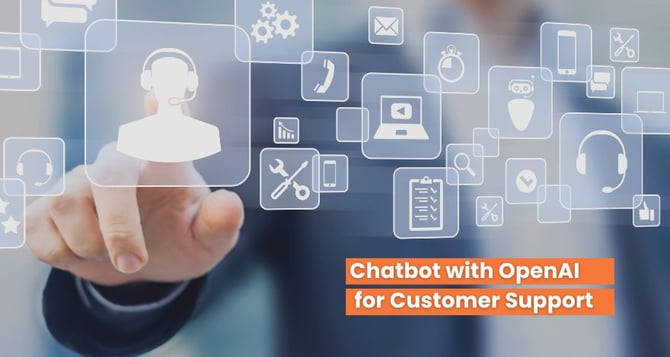Building a Chatbot with OpenAI GPT-3 for Customer Support
Learn to create a robust customer support chatbot with OpenAI's GPT-3. This guide covers goal setting, API integration, NLP implementation, and multi-turn conversation handling, providing essential steps and Python code snippets for efficient development.

Building a chatbot for customer support using OpenAI's GPT-3 can be a powerful way to automate and enhance customer service interactions. Here's a step-by-step guide to help you get started:
1. Understand Your Goals: Define the specific goals and objectives of your customer support chatbot. What tasks or inquiries do you want it to handle? Common tasks include answering frequently asked questions, providing product information, assisting with troubleshooting, and more.
2. Access GPT-3: Ensure you have access to OpenAI's GPT-3 API. You may need to apply for access and obtain API keys from OpenAI.
3. Data Collection and Preprocessing: Gather and preprocess the data that your chatbot will need to understand and respond to user queries. This can include FAQs, product manuals, and previous customer interactions.
4. Choose a Framework or Platform: Decide whether you want to build your chatbot from scratch or use a chatbot development platform. Platforms like Dialogflow, Microsoft Bot Framework, or Rasa can help streamline the development process.
5. Set Up the Environment: Set up your development environment and install any necessary libraries or SDKs for interacting with the GPT-3 API.
6. Design Conversation Flow: Plan the conversation flow and user interactions. Consider the different types of questions and user inputs your chatbot will encounter.
7. Integrate GPT-3: Connect your chatbot to the GPT-3 API. You'll need to send user messages to the API and process the responses. Make sure to handle authentication and API rate limits.
8. Train and Fine-Tune: Train your chatbot to understand user queries and generate relevant responses. You may need to fine-tune the GPT-3 model using specific prompts and examples related to your domain.
9. Implement Natural Language Processing (NLP): Use NLP techniques to improve the understanding of user input and to extract important information from the conversation.
10. Handle Common Scenarios: Implement logic to handle common customer support scenarios, such as:
- Identifying and greeting users.
- Responding to frequently asked questions.
- Providing accurate and helpful information.
- Handling escalations to human agents when necessary.
- Managing multi-turn conversations.
11. Testing and Evaluation: Thoroughly test your chatbot to ensure it performs well in real-world scenarios. Gather feedback from users and make necessary improvements.
12. Security and Privacy: Ensure that the chatbot complies with data privacy regulations and security standards. Handle sensitive customer information responsibly.
13. Scaling and Maintenance: As your chatbot gains more users and handles a larger volume of queries, be prepared to scale your infrastructure and continuously maintain and update your chatbot to improve its performance.
14. User Training: Encourage users to provide feedback and corrections to help improve the chatbot's responses over time.
15. Monitoring and Analytics: Implement monitoring and analytics tools to track the chatbot's performance, identify bottlenecks, and make data-driven improvements.
16. Documentation and User Support: Provide clear documentation and support resources for users interacting with your chatbot.
17. Compliance and Ethical Considerations: Ensure that your chatbot adheres to ethical guidelines and avoids biases or inappropriate responses.
Building a customer support chatbot is iterative, requiring constant refinement based on user feedback and evolving customer needs. Staying current with NLP and AI advancements is key for competitive ChatGPT Development. Here are Python code snippets to kickstart your OpenAI's GPT-3 chatbot journey.
Setting Up GPT-3 API Client
You'll need to install the `openai` Python package and set up your API key first:

Sending a Message to GPT-3
Here's how you can send a user message to GPT-3 and get a response:

Building a Conversation Loop
You can create a loop to handle a conversation with the user:

Remember to handle various user inputs, manage conversation history, and potentially add logic for specific tasks or intents.
Handling Multi-Turn Conversations
For multi-turn conversations, you'll want to maintain conversation history and context. Here's a simple example:

This code snippet maintains a conversation history by appending user and assistant messages to the `conversation_history` list.
Choose Our AI Development Solutions for Success!
From concept to deployment, we bring your vision to life through advanced AI development. Reach out to our experts to discuss your project.
Please Note that these are simplified code snippets to get you started. In a production environment, you'll need to handle various scenarios, including error handling, user authentication, and more sophisticated conversation management.


%201-1.webp)


.png?width=344&height=101&name=Mask%20group%20(5).png)







.png?width=352&name=Agentic%20AI%20vs%20Traditional%20Automation%20Which%20Gives%20best%20Enterprise%20ROI%20(1).png)
.png?width=352&name=microsofts-recall-feature%20(11).png)







